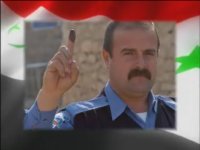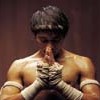Agam's Gecko


Saturday, April 05, 2008
THE TONGKOR INCIDENT
| F |
urther accounts of the shooting of Tibetan protesters in Kardze "TAP" Kham, (Ch: Sichuan province) on April 3 are given by Times Online. The Times gives the village name as Donggu (probably a sinification of Tongkor), near the "sprawling ancient hillside monastery of Tongkor."
The demands by officials for denunications of Dalai Lama, the subsequent room searches and desecration of religious icons, and the arrests took place April 2. The following day, all the monks of Tongkor (around 400) and a similar number of lay people gathered to demand the detainees' release.
About 6.30pm, the entire monastic body marched down to a nearby river, where paramilitary police were encamped and demanded the release of the two men. They were joined by several hundred local villagers, many of them enraged at the detention of the elderly monk, who locals say is well respected in the area for his learning and piety.Look at all the Chinese name transliterations for the Tibetans there.
Shouting “Long Live the Dalai Lama”, “Let the Dalai Lama come back” and “We want freedom”, the crowd demonstrated until about 9pm.
Witnesses said that up to 1,000 paramilitary police used force to try to end the protest and opened fire on the crowd. In the gunfire, eight people died, according to a local resident in direct contact with the monastery. These included a 27-year-old monk identified as Cangdan and two women named as Zhulongcuo and Danluo.
Witnesses said that a 30-year-old villager, Pupu Deley, was killed, with the son of a villager named Cangdan, and the daughter of a villager called Cuogu. Two other people, whose identities were not available, were also killed, the witnesses said. Among those wounded was one person with a bullet through the ear and another shot in the shoulder. About 10 people were still missing yesterday, including another monk, Ciwang Renzhen.
One witness, who declined to be identified, said: “People were very angry after the old lama was detained. He is very much loved and so many ordinary people were very excited.”
 Monks demonstrate in Kardze town, 60 km from Tongkor, last month. Photo: EPA |
At one point, some officials apparently threw pictures of the Dalai Lama and of the monastery's exile tulku, Tongkor Shabdrung, on the ground, according to reliable sources. A monk in his seventies, Tsultrim Tenzin, and another monk in his late twenties, Yeshe Nyima, protested about the work team's actions, and later, the monks were told that they had to denounce the Dalai Lama. The incident escalated after monks objected when Tsultrim Tenzin, and later, Yeshe Nyima, were taken into custody.Xinhua says police were "forced to fire warning shots and put down the violence," giving no account of casualties other than a government official who was said to be injured.
Many or most of the 350-strong monastic community began a protest, joined by some laypeople, calling for the Dalai Lama to return home and for the release from detention of the monks from Tongkor, according to several reliable Tibetan sources with connections to the area. Armed police were deployed and shot at the crowd, killing at least eight Tibetans. Some monks were reportedly injured by gunfire, and more than ten monks are reportedly missing.
ICT also gives some background on this particular area.
Ganzi, one of 18 counties in the prefecture, has been the site of more known political detentions of Tibetans (55) by Chinese authorities than any other county outside the Tibet Autonomous Region (TAR) since the current period of Tibetan political activism began in 1987, based on data available in the Congressional-Executive Commission on China (CECC) Political Prisoner Database (PPD).Radio Free Asia has spoken to people in the district, and says the death toll is still unknown.
At about 8 p.m. April 3, paramilitary People’s Armed Police fired on a crowd of several hundred monks from the Tongkor monastery in Kardze (in Chinese, Ganzi) and several hundred residents, witnesses told RFA’s Tibetan service.Authorities had tried to enlist the monastery's abbot, Lobsang Jamyang, on April 2 in their efforts to force the monks to denounce Dalai Lama. He is said to have told them, "We cannot criticize the Dalai Lama, but I will discourage any incidents of protest here." At a meeting of about 400 monks, they unanimously agreed that, "We cannot criticize the Dalai Lama, even at the cost of our lives."
The witnesses, who declined to be identified, said they believed 15 people were killed and dozens injured, with scores more unaccounted for as of April 4. Phone communication with the region was cut off after the shooting and no further information was available.
When Lobsang Jamyang recounted this to the police officer in charge, he replied: "We can use the challenge. Tell anyone who wants to rise up to go ahead and rise up, and we will crush them."The monks' quarters were searched, photos of Dalai Lama were found and destroyed, a portrait of the previous abbot was removed, and the two people (one an elderly monk, the other said to be a young man who worked at the monastery) were arrested.
The following day, some 350 monks and another 350 lay people gathered to demand the men’s release. Officials told them to leave for 25 minutes and calm themselves, and the men would be freed. But the crowd refused to disperse, and at 8 p.m. police opened fire on the crowd at Tongkor subdivision, witnesses said.Local officials contacted by RFA denied that anything had happened, assuring that "everything is fine." A Han Chinese resident of the area said scenes of "smashing and looting" were broadcast on local television.
Open demand to Chinese leaders: If you have nothing to hide, then let the journalists in.











 Our way of saying "thanks" in the Thai way. Here a nak muay Thai (kickboxer) offers respect and thanks for his teacher (wai khru) before a match. This is our local variation on the ubiquitous "hat tip" used in general blog culture.
Our way of saying "thanks" in the Thai way. Here a nak muay Thai (kickboxer) offers respect and thanks for his teacher (wai khru) before a match. This is our local variation on the ubiquitous "hat tip" used in general blog culture.






